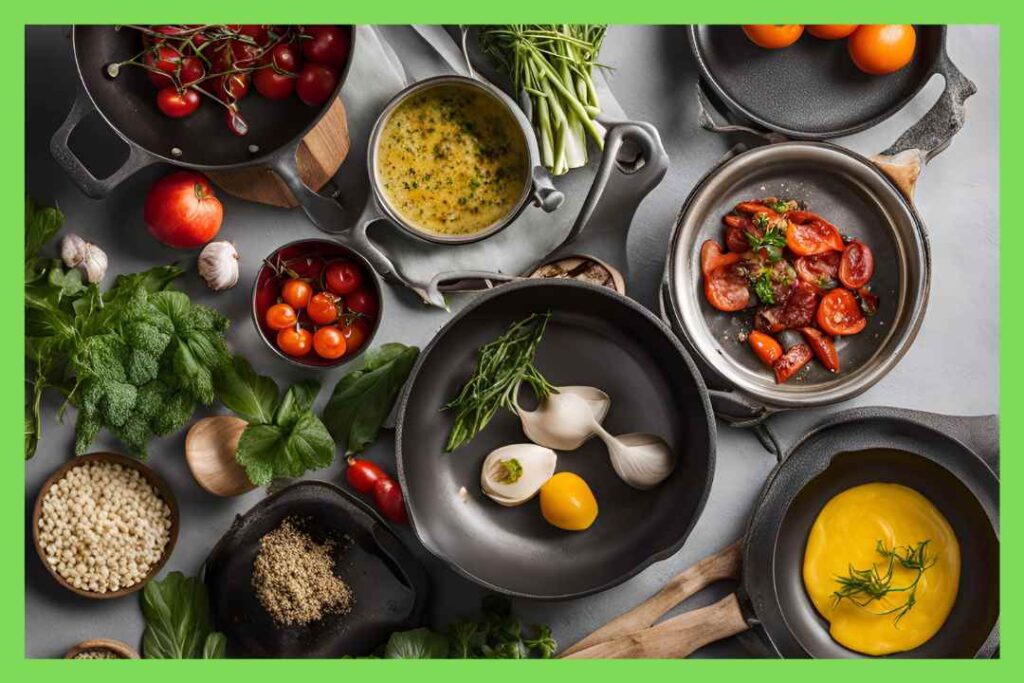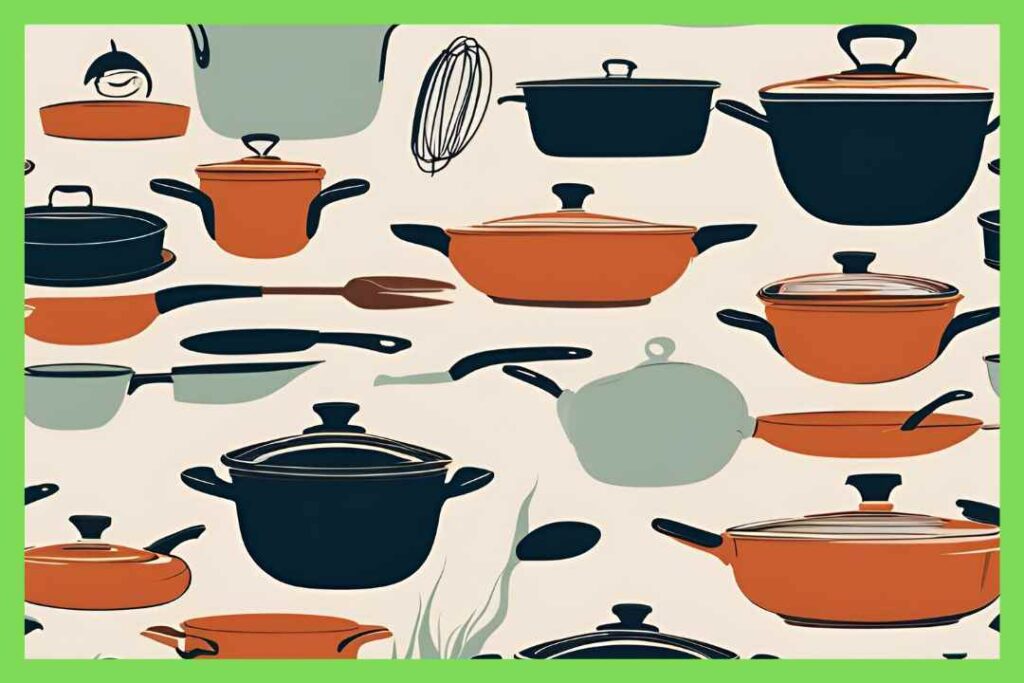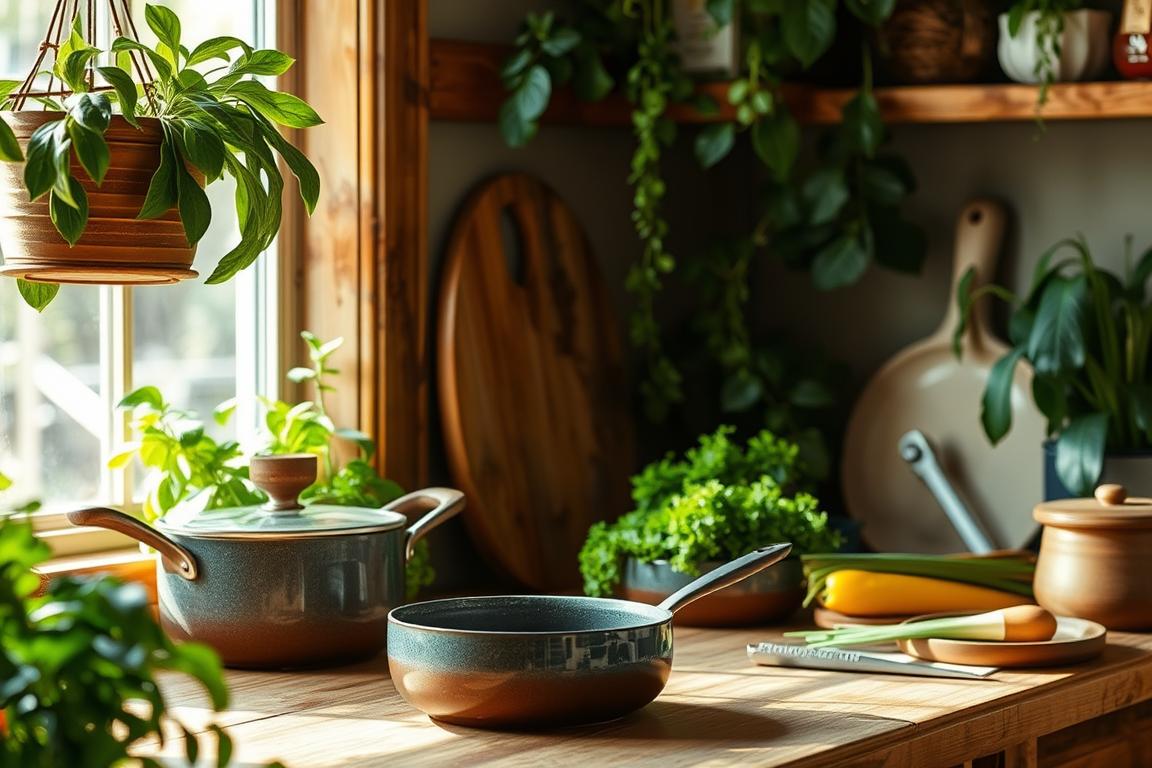In today’s world, kitchens are getting greener. More home cooks are choosing eco-friendly cooking and sustainable cookware. They want to lessen their environmental footprint. But why is sustainable cookware a key item for kitchens in 2024?
The need for sustainable cuisine and green kitchen solutions is growing. Home cooks are looking for durable, eco-friendly cookware. This shift is driven by a desire for health and sustainability in the kitchen.
Embracing a Greener Kitchen

The kitchen is now a key area for those wanting to live more sustainably. People are learning how traditional cookware and cooking methods harm the environment. This includes the energy needed to make and ship these items, plus the waste they create.
The Growing Demand for Sustainable Living
Today, people are more aware of their environmental impact. They look for eco-friendly products like energy-saving appliances and organic foods. They also choose items with little packaging, like locally grown produce.
The Impact of Traditional Cookware
Old-fashioned cookware, made from materials like Teflon or aluminum, harms the planet. Making these items uses a lot of energy and resources. When they’re thrown away, they add to landfill waste and pollution.
Also, the chemicals in these cookware can get into our food. This can be bad for our health and safety.
| Traditional Cookware | Eco-Friendly Cookware |
|---|---|
| Teflon-coated pans Aluminum pots and pans Plastic utensils and containers | Stainless steel cookware Cast iron skillets Bamboo or silicone utensils |
As people learn more about their choices, they want sustainable cookware and kitchen items. By choosing a greener kitchen, we can help the planet. We also get to enjoy the perks of energy-saving appliances, organic foods, and less packaging.
Eco-Friendly Cooking: A Holistic Approach

Eco-friendly cooking is more than just the right cookware. It’s a full approach that covers the whole cooking process. It means using plant-based foods, making zero-waste meals, and managing waste well through composting.
Looking at the kitchen’s impact on the environment can make a big difference. Home cooks can cut down their carbon footprint and still enjoy tasty, healthy meals. Let’s explore the main parts of eco-friendly cooking:
- Plant-Based Eating: Eating more plant-based foods like fruits, veggies, grains, and legumes can greatly reduce your carbon footprint. These foods usually have a lower environmental impact than animal products.
- Zero-Waste Meals: Reducing food waste is key in eco-friendly cooking. This includes planning meals, storing food right, and using every part of an ingredient. For example, using veggie scraps for stock or composting.
- Composting: Composting food scraps and other organic waste keeps them out of landfills. Landfills produce methane, a strong greenhouse gas. Composting turns waste into nutrient-rich soil for your garden or plants, closing the loop of sustainable living.
By taking a holistic view of eco-friendly cooking, you can help create a more sustainable future. And you’ll enjoy delicious, healthy meals along the way.
“Sustainable cooking is not just about the cookware; it’s a mindset that permeates every aspect of the culinary experience.”
The Benefits of Sustainable Cookware
Choosing eco-friendly cooking tools and energy-efficient appliances is good for your family and the planet. They help make healthier meals, save money, and reduce waste. Sustainable cookware brings many benefits to the modern kitchen.
Healthier Meals, Healthier Planet
Traditional cookware can contain harmful chemicals that get into your food. Using eco-friendly cooking options made from safe materials keeps your meals safe and tasty. This choice is better for your health and helps the planet by cutting down on waste and pollution.
Long-Lasting and Cost-Effective
Energy-efficient appliances and sustainable cookware last a long time. They might cost more upfront, but they save money in the long run. They also reduce the need for frequent replacements, which is better for the environment.
| Benefits of Sustainable Cookware | Traditional Cookware | Sustainable Cookware |
|---|---|---|
| Health Impact | May Contain Harmful Chemicals | Non-Toxic, Natural Materials |
| Environmental Impact | Contributes to Waste and Pollution | Reduced Waste and Emissions |
| Durability | Short-Lived, Frequent Replacements | Long-Lasting, Durable Construction |
| Cost-Effectiveness | Frequent Replacements Increase Costs | Higher Initial Investment, Lower Long-Term Costs |
Choosing sustainable cookware means healthier meals and a greener future. It’s a smart choice for those who care about quality, health, and the environment. It’s a win-win for your family and the planet.
Choosing the Right Sustainable Cookware
The demand for sustainable cuisine and green kitchens is on the rise. This has led to a wider range of eco-friendly cookware options. Finding the right sustainable cookware can seem overwhelming. But, with the right guidance, you can find the perfect piece to enhance your cooking and reduce your environmental impact.
Materials to Look For
When choosing sustainable cookware, the materials used are key. Look for items made from renewable, non-toxic, and durable materials. Some top choices include:
- Ceramic: It’s durable, non-reactive, and free from harmful chemicals.
- Stainless steel: It’s long-lasting, resistant to corrosion, and easy to clean.
- Cast iron: It’s versatile, naturally non-stick, and can last for generations.
- Bamboo: It’s a fast-growing resource that’s biodegradable and compostable.
Reputable Brands and Certifications
To make sure you’re getting truly sustainable cookware, look into reputable brands. These brands focus on environmental responsibility and social impact. Check for certifications like USDA Organic, Fair Trade, or B-Corp. These show the company’s dedication to sustainability. Some top brands include:
| Brand | Certifications | Sustainable Features |
|---|---|---|
| GreenPan | PFOA-free, Cradle to Cradle Certified | Durable ceramic non-stick coating, recycled aluminum construction |
| Calphalon | SCS Global Services Certified, EPA Energy Star Partner | Hard-anodized aluminum, designed for energy-efficient cooking |
| Zwilling | PFOA-free, LFGB Certified | Forged stainless steel construction, minimal packaging |
By choosing sustainable materials and reputable brands, you support eco-friendly cooking. This helps create a greener future for all.
Eco-Friendly Cooking Tips and Tricks
Going green in the kitchen is more than just using the right cookware. It’s about changing how we think and act. We can reduce waste, save energy, and make tasty, eco-friendly meals. This guide will show you how to make sustainable cooking a part of your daily life.
Meal Planning for Zero-Waste Meals
Plan your meals for the week to cut down on food waste. Make a list of what you need and only buy what you’ll use. Try to include more plant-based eating in your diet. It’s good for the planet.
Composting for a Greener Kitchen
Start composting to turn kitchen waste into soil for your garden. Keep a compost bin in your kitchen. It’s easy to make it a habit to throw away food scraps and peels the right way.
Energy-Saving Cooking Techniques
Use energy-saving cooking methods like the microwave or Instant Pot. Covering pots and pans helps keep heat in. Try to make some meals without cooking at all to save even more energy.
| Sustainable Cooking Tip | Benefits |
|---|---|
| Plan meals in advance | Reduces food waste and saves money |
| Embrace plant-based eating | Lowers environmental impact |
| Compost food scraps | Diverts waste from landfills, creates nutrient-rich soil |
| Use energy-efficient cooking methods | Saves energy and reduces utility costs |
By following these eco-friendly cooking tips, you can make a big difference. You’ll enjoy delicious meals and help the planet at the same time.
“Sustainable cooking is not just about the cookware – it’s a mindset that permeates every aspect of the culinary experience.”
The Future of Sustainable Kitchens
The kitchen of the future is set for a big change. With more people wanting to cook in an eco-friendly way, new ideas are coming to life. We’re seeing better appliances and more eco-friendly packaging options.
Smart home tech is playing a big role in this change. Now, we have kitchen gadgets that use green energy and work super efficiently. These smart appliances help us save energy and learn how to cook better for the planet.
Also, more people are choosing plant-based foods and wanting sustainable food systems. This means we’re looking for products with less packaging and a smaller environmental impact. Brands are now making minimal packaging that’s good for the planet but still great for us.
FAQ
What is eco-friendly cooking, and why is it important?
Eco-friendly cooking means using green cookware and ingredients. It’s key because it cuts down kitchen carbon footprints. It also supports a greener planet and safer cooking tools.
What are the key benefits of using sustainable cookware?
Sustainable cookware offers healthier meals and lasts longer. It’s also better for the environment. Eco-friendly options use safer materials and less energy.
What materials should I look for in sustainable cookware?
Look for stainless steel, cast iron, ceramic, and borosilicate glass. These are durable and safe. They also don’t have harmful chemicals found in non-stick coatings.
What are some top sustainable cookware brands to consider?
Top brands include GreenPan, Caraway, Scanpan, and Lodge. They focus on eco-friendly production and use recycled materials. They also meet strict standards like PFOA-free and Greenguard.
How can I incorporate more sustainable practices into my cooking routine?
Use eco-friendly cookware and choose local, organic ingredients. Plan meals to reduce waste and compost. Try energy-saving cooking methods like pressure or slow cooking.
What are some of the emerging trends in sustainable kitchen design?
Trends include smart home tech for energy saving and renewable materials like bamboo. There’s also a focus on composting and waste reduction.
